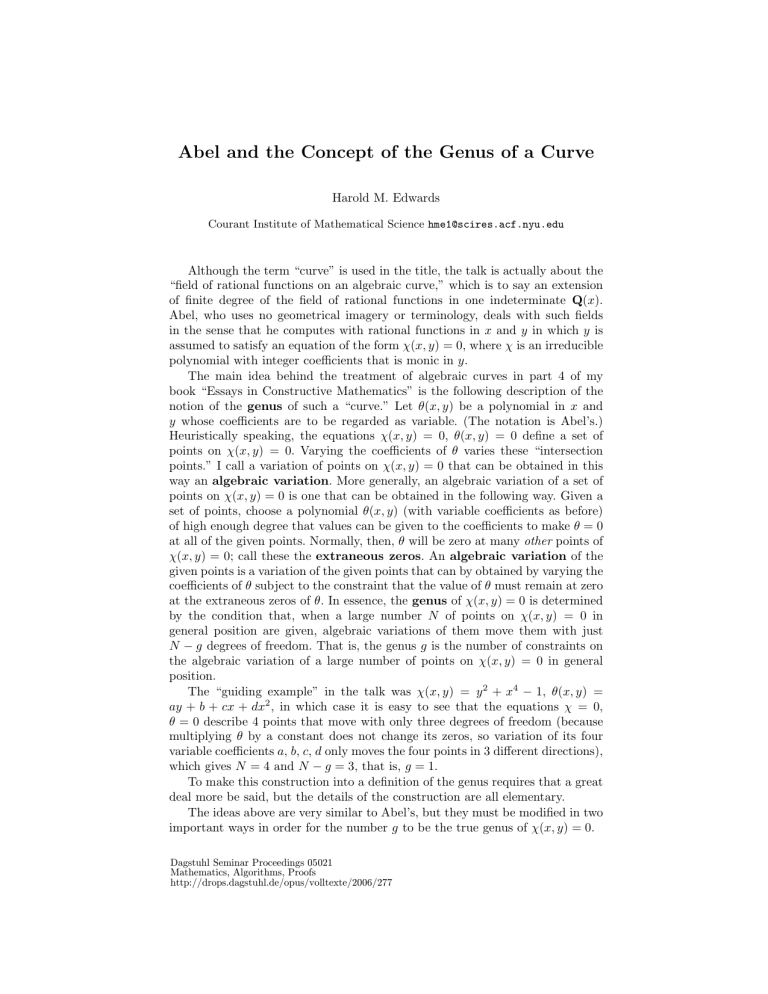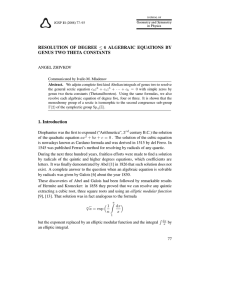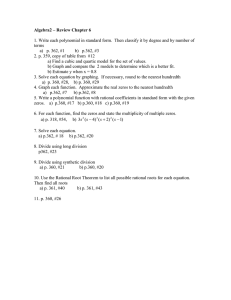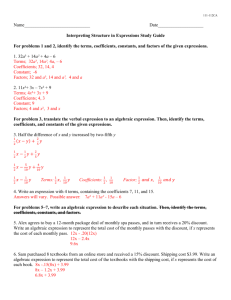Abel and the Concept of the Genus of a Curve

Abel and the Concept of the Genus of a Curve
Harold M. Edwards
Courant Institute of Mathematical Science hme1@scires.acf.nyu.edu
Although the term “curve” is used in the title, the talk is actually about the
“field of rational functions on an algebraic curve,” which is to say an extension of finite degree of the field of rational functions in one indeterminate Q ( x ).
Abel, who uses no geometrical imagery or terminology, deals with such fields in the sense that he computes with rational functions in x and y in which y is assumed to satisfy an equation of the form χ ( x, y ) = 0, where χ is an irreducible polynomial with integer coefficients that is monic in y .
The main idea behind the treatment of algebraic curves in part 4 of my book “Essays in Constructive Mathematics” is the following description of the notion of the genus of such a “curve.” Let θ ( x, y ) be a polynomial in x and y whose coefficients are to be regarded as variable. (The notation is Abel’s.)
Heuristically speaking, the equations χ ( x, y ) = 0, θ ( x, y ) = 0 define a set of points on χ ( x, y ) = 0. Varying the coefficients of θ varies these “intersection points.” I call a variation of points on χ ( x, y ) = 0 that can be obtained in this way an algebraic variation . More generally, an algebraic variation of a set of points on χ ( x, y ) = 0 is one that can be obtained in the following way. Given a set of points, choose a polynomial θ ( x, y ) (with variable coefficients as before) of high enough degree that values can be given to the coefficients to make θ = 0 at all of the given points. Normally, then, θ will be zero at many other points of
χ ( x, y ) = 0; call these the extraneous zeros . An algebraic variation of the given points is a variation of the given points that can by obtained by varying the coefficients of θ subject to the constraint that the value of θ must remain at zero at the extraneous zeros of θ . In essence, the genus of χ ( x, y ) = 0 is determined by the condition that, when a large number N of points on χ ( x, y ) = 0 in general position are given, algebraic variations of them move them with just
N − g degrees of freedom. That is, the genus g is the number of constraints on the algebraic variation of a large number of points on χ ( x, y ) = 0 in general position.
The “guiding example” in the talk was χ ( x, y ) = y 2 + x 4 − 1, θ ( x, y ) = ay + b + cx + dx 2 , in which case it is easy to see that the equations χ = 0,
θ = 0 describe 4 points that move with only three degrees of freedom (because multiplying θ by a constant does not change its zeros, so variation of its four variable coefficients a , b , c , d only moves the four points in 3 different directions), which gives N = 4 and N − g = 3, that is, g = 1.
To make this construction into a definition of the genus requires that a great deal more be said, but the details of the construction are all elementary.
The ideas above are very similar to Abel’s, but they must be modified in two important ways in order for the number g to be the true genus of χ ( x, y ) = 0.
Dagstuhl Seminar Proceedings 05021
Mathematics, Algorithms, Proofs http://drops.dagstuhl.de/opus/volltexte/2006/277
2 Harold M. Edwards
First, θ was assumed to be a polynomial, but the correct assumption is that
θ is integral over x .
This notion of integrality, now very familiar, was, as far as I know, not developed until it appeared in the works of Kronecker and Dedekind.
This change in the conditions means, if it makes any difference at all, that there are more possibilities for θ , so there may be more algebraic variations of a given set of points and the genus may be reduced.
Second, the description above suggests computations involving rational numbers only, but the natural field of constants to be used is the field of constants on χ ( x, y ) = 0—all rational functions (elements of the field) that are integral both over x and over 1 /x . This adjustment is necessary to get the right count of the “number of points” and the “number of variable coefficients.”
These considerations lead to the following description of the genus of
χ ( x, y ) = 0:
Let A be the field of constants on the given curve. Let χ
1
( x, y ) be an irreducible factor of χ ( x, y ) over A that is monic in y , and let n
1 be the degree of χ
1
( x, y ) in y . (In most cases, A = Q so χ
1 number ν , let Θ ( x ν ) be the vector space, over
=
A
χ and n
1
= n .) For a large
, of all rational functions that are integral over x and that become integral over 1 /x when they are divided by x ν . The genus g is determined by the condition that the dimension of Θ ( x ν ) is n
1
ν − g + 1, as is made plausible by the following considerations.
Each value of x corresponds to n
1 values of y (the roots of χ ( α, y ) where α is the given value for x ), which is to say that each value of x occurs at n
1 of the curve. In particular, x has n
1 points poles on the curve. An element of Θ ( x ν ), because it has poles of order ν , at most, at poles of x and there are n
1 has at most n
1
ν poles. In fact, the subset of Θ ( x
ν poles of x
) consisting of functions with
, fewer than n
1
ν poles is sparse and can be ignored. Therefore, a generic element of Θ ( x
ν of Θ ( x
ν
) has n
1
ν zeros and is described by d constants, where d is the dimension
) as a vector space over A . Varying the d constants that describe the function varies its n
1
ν zeros with d − 1 degrees of freedom (because multiplying by a constant does not change the zeros). By the definition of the genus, then, d − 1 = n
1
ν − g , which is the desired formula d = n
1
ν − g + 1 .
In this way, the determination of the genus of χ ( x, y ) = 0 is translated into a problem in algebra, primarily in linear algebra.







